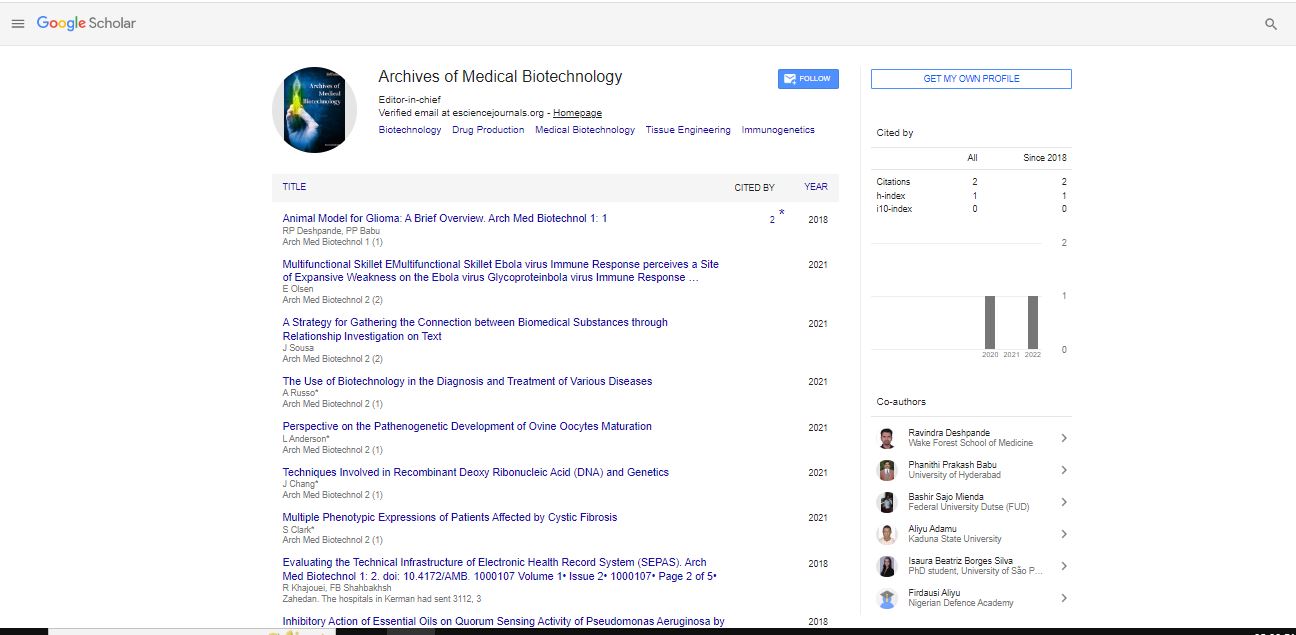Commentary, Arch Med Biotechnol Vol: 4 Issue: 2
Nanomedicine: Advancements in Targeted Drug Delivery
Kharel Mena*
Department of Physiology, Kathmandu Medical College and Teaching Hospital, Kathmandu, Nepal
*Corresponding Author: Kharel Mena,
Department of Physiology, Kathmandu
Medical College and Teaching Hospital, Kathmandu, Nepal
E-mail: menak@gmail.com
Received date: 22 May, 2023, Manuscript No. AMB-23-106363;
Editor assigned date: 24 May, 2023, PreQC No. AMB-23-106363 (PQ);
Reviewed date: 16 June, 2023, QC No. AMB-23-106363;
Revised date: 26 June, 2023, Manuscript No. AMB-23-106363 (R);
Published date: 03 July, 2023 DOI: 10.4172/amb.1000045.
Citation: Mena K (2023) Nanomedicine: Advancements in Targeted Drug Delivery. Arch Med Biotechnol 4:2.
Abstract
Nanomedicine has revolutionized the field of drug delivery by enabling the design and development of targeted and controlled release systems. Providing a comprehensive overview of nanomedicine, focusing on its applications in targeted drug delivery, by exploring the unique properties of nanomaterials that make them ideal for drug delivery, including their high surface area, tunable size, and ability to encapsulate and protect drugs. The manuscript discusses various nanocarrier systems, such as liposomes, nanoparticles, and dendrimers, and their applications in delivering a wide range of therapeutic agents. It also explores the challenges and considerations associated with nanomedicine and highlights the future prospects of this field in improving drug efficacy and reducing side effects.
Keywords: Nanomedicine; Drug efficacy; Liposomes
Description
The nanomedicine and its role in targeted drug delivery. It emphasizes the need for innovative approaches to enhance drug efficacy and reduce side effects. The manuscript highlights the unique properties of nanomaterials that make them ideal candidates for drug delivery systems.
Properties of nanomaterials
This section explores the properties of nanomaterials that enable targeted drug delivery. It discusses the high surface area-to-volume ratio of nanomaterials, which allows for efficient drug loading, by highlighting the tunable size of nanomaterials, enabling precise control over drug release kinetics. Additionally, it discusses the ability of nanomaterials to protect drugs from degradation and enhance their solubility, stability, and bioavailability.
Liposomes as nano-carriers
This section focuses on liposomes, a widely used nanocarrier system for drug delivery. It discusses the structure and composition of liposomes and their ability to encapsulate both hydrophilic and hydrophobic drugs, exploring the advantages of liposomes, such as prolonged circulation time and reduced toxicity, and highlights their applications in delivering therapeutic agents in cancer, infectious diseases, and other conditions.
Nanoparticles for targeted drug delivery
This section delves into the use of nanoparticles as nan carriers for targeted drug delivery. It discusses different types of nanoparticles, including polymer nanoparticles and metallic nanoparticles, and their unique properties, exploring the surface functionalization of nanoparticles for active targeting, enabling specific interactions with target cells or tissues. It also highlights the potential applications of nanoparticle-based drug delivery systems in various diseases.
Dendrimers in drug delivery
This section explores dendrimers, highly branched polymer structures, as Nano carriers for drug delivery. It discusses the unique properties of dendrimers, such as their well-defined structure and ability to encapsulate drugs within their interior or conjugate them on their properties, exploring the potential of dendrimers in controlled release and targeted drug delivery.
Applications of nanomedicine in drug delivery
This section discusses the applications of nanomedicine in targeted drug delivery. It explores the use of nanocarrier systems in delivering various therapeutic agents, including small molecules, proteins, peptides, nucleic acids, and gene editing tools like CRISPR-Cas9, highlighting the successful examples of nanomedicine-based drug delivery systems in cancer treatment, infectious diseases, and neurological disorders.
Challenges and considerations
This section addresses the challenges and considerations associated with nanomedicine. It discusses the scale-up production of nanocarrier systems, regulatory considerations, and potential long-term toxicity of nanomaterials, by emphasizing the importance of safety, nanomaterials, by emphasizing and translation of nanomedicine-based drug delivery systems.
Future perspectives
The conclusion highlights the transformative potential of nanomedicine in targeted drug delivery. It discusses the future prospects of nanomedicine, such as the development of novel nanocarrier systems, advances in surface functionalization, and the integration of nanomedicine with personalized medicine approaches, in emphasizing the need for continued analysis, collaboration, and regulatory support to harness the full potential of nanomedicine in improving drug efficacy and reducing side effects.
Conclusion
In summary, nanomedicine offers remarkable advancements in targeted drug delivery, by exploring the properties of nanomaterials that make them suitable for drug delivery systems and discusses the applications of nanocarrier systems, such as liposomes, nanoparticles, and dendrimers, in delivering therapeutic agents. It also addresses the challenges and considerations associated with nanomedicine and highlights the future prospects of this field in improving drug efficacy and reducing side effects, ultimately leading to enhanced patient outcomes.
 Spanish
Spanish  Chinese
Chinese  Russian
Russian  German
German  French
French  Japanese
Japanese  Portuguese
Portuguese  Hindi
Hindi 